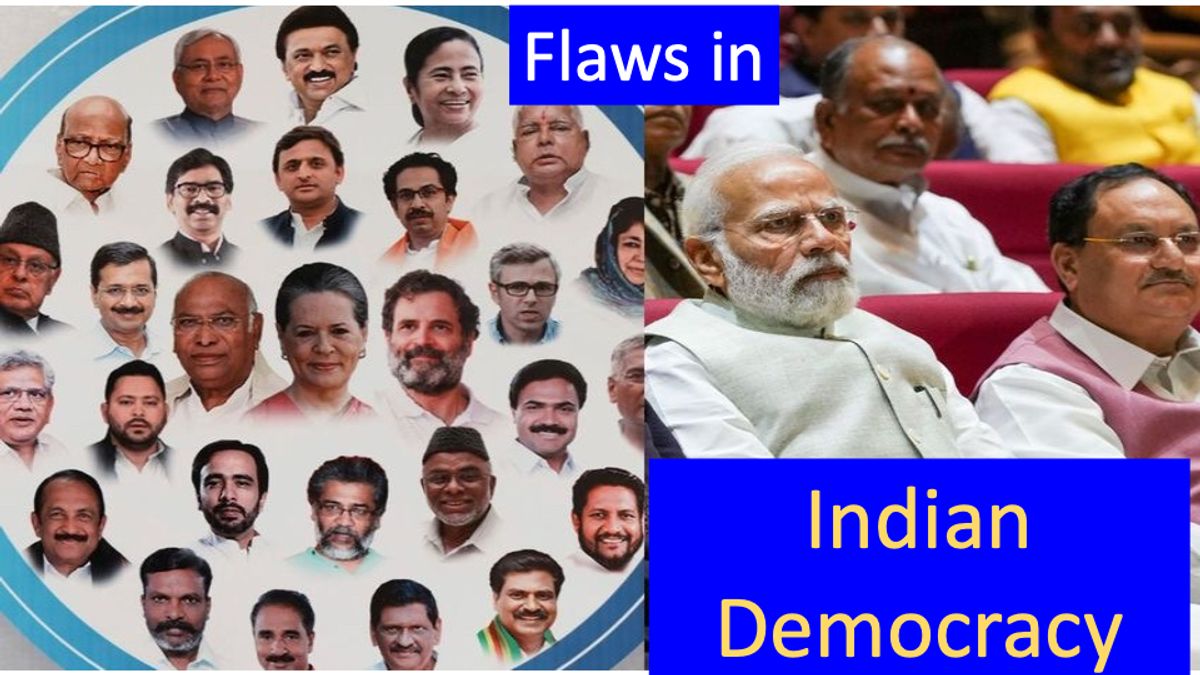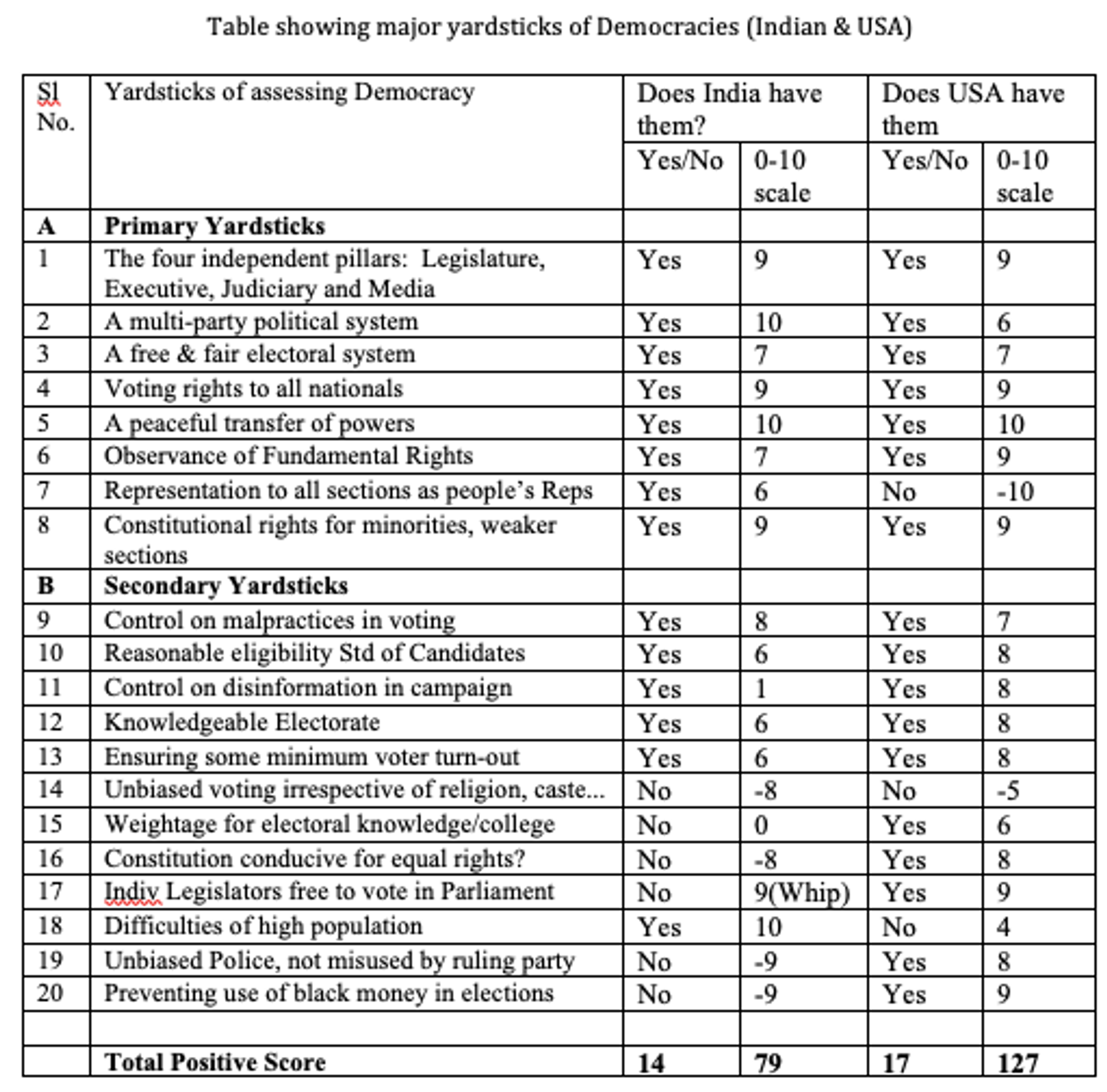
India a Flawed Democracy
India and its Flawed Democracy
India is the largest democracy in the world. However, the name ‘India’ itself is flawed. This name defies the antecedents of a nation which has very rich cultural heritage of tens of thousands of years of its dominant existence. India name was given by an occupying regime of British. The very name that doesn’t incorporate the original identity and heritage of a nation, is surely flawed. A name of a nation is invariably a continuum of its existence since origin. Since Muslim invaders tried to destroy our history for centuries, we as nation suffered a lot. What we inherit today is only a miniscule of our rich culture. The nation “Aryavart” was a vast piece of territory which kept fragmented due to socio-political differences. What is left today as ‘India’ is only a fraction of our erstwhile motherland. All others are the generations of invaders and settlers. Some alien culture got a foothold on our territories becoming a rapidly proliferating cancerous disease. The treatment of this cancer was an intricate surgery to severe the disease from the main body. Hence, when we talk of a nation called India, it implies only a miniscule part of our inheritance.
India has been an exemplary civilization which had all kinds of administrations. There had been kingdoms with some iconic versions of democracies and care for citizens, an ideal king who could risk own lives for the safety of its citizens. The invaders belonged to alien religions and cultures, some even equivalent to demonic. The current principles and practices of Indian democracy has been borrowed from the British as “of the people, by the people, and for the people.” Since the entire emphasis is on the people, a big question arises, who are these people? Do they have an the understanding of their democracy, the candidates, their aspirations? Not many of the people are aware of it. The form of democracy is not flawless.
Western Concepts of Democracies
Coming back to the often flawed concept of western democracy, it is unfortunate that hardly any useful reforms have taken place to make it much acceptable one on the wider platforms. By now almost half the nations in the world are trying to adopt/implement democracy on their own or forced by western powers having significant influence on them. There is no doubt that democracy is good for people of a nation provided they understand its basic tenets and principles. However, it is also true that democracy is reasonably counterproductive in many of the issues esp in the cases of decision-making by consensus or voting rights.
In the present times, many organisations have become a self-appointed jury to judge how democratic a nation is. However, there is no universally accepted criteria. Many of the yardsticks of judging any democracy is full of subjectivity hence, unreliable. Democratic practices in a small country is very much workable but it becomes a horrendous task in most populous country where sizable numbers of citizens don’t know how to exercise democratic rights. The text-box below mentions some of the yardsticks of democracy and a comparison of the world’s largest and oldest democracies as to how they fair. With the parameters in vogue, It will be wrong to compare the democracies in India having >1.4 billion people with that of Norway (5.4 million) or Iceland (0.38 million). There are numerous practical difficulties in governance of such a large populace thru’ democratic norms. table below shows various parameters of a democracy, comparing India to the USA. No doubt, there are flaws in both but Indian democracy has to go long way to compete. Indian constitution guiding its democracy too seems flawed.
Democratic Norms or Yardsticks
The very basic principles of the western concept of democracy, “of the people, by the people” is unworkable. The next best compromise is the “of and by the elected representatives of people” some of whom may be either unfriendly or inimical towards those who didn’t elect them. This in principle defeats the very root of “of, by and for the people”. Hence, no country having elected representative, could be an ideal democracy. The governance at best is by the elected/nominated representatives. There are some Primary sets of yardsticks for a democracy that directly affects the model of governance as well as Secondary sets, that indirectly influences the primary parameters.
Primary Yardsticks
Four Pillars of Democracy. Legislature, Executive, Judiciary and Media are considered as the four primary pillars of a democracy. The Legislatures are the elected representatives of the people who formulate the requisite Legislations in accordance with the Constitution of that nation. It is pertinent that the legislations don’t violate the Fundamental Rights of the people for which any piece of legislation could be subjected to Judicial Reviews. Executives lay down the frameworks to implement the legislation overseen by the judiciary. Media play a very active role in reporting any wrong-doing. Both India and USA have strong sets of these four pillars.
A Multi-Party Political System. In a democracy, there is bound to be people having different ideologies…some of ‘centrist’ and others of ‘left’ or ‘right’. Political parties of all these ideologies should find some platforms to go to the electorate for representation in the parliament. In India there are numerous political parties of which 8 are national, 57 regional and 2764 unrecognised parties. Although there could be merits and demerits of such large numbers of parties, it incorporates political participations by most if not all sections of citizens. On the other hand, there are many nations incl the oldest democracy USA that have limited number of political parties as little as two (Democat & Republicans in USA) which is not an ideal form of polity to govern a state democratically.
A Free and Fair Electoral System. The core of democracy is an independent, free and fair electoral system largely isolated from the influence of the government. It should be a constitutional body that should manage timely elections, confidentiality of voting, encourage participation by as many electorate as possible and no citizen should be barred from voting. They must periodically update the electoral roll of eligible voters, remove duplicate voters and screen out foreigners. All eligible voters must be able to cast their votes without violence or intimidation. On this account, India had suffered a lot in the past when musclemen used to capture booths and indulge in bogus voting. This has improved vastly after un-tamperable electronic voting machine (EVMs) were introduced. West Bangal in India has proven this wrong when political party of Mamata Banerjee’s TMC intimidated, physically and sexually assaulted its own citizen who voted for opponent political party after the conclusion of 2019 election (read “Murder of Democracy in West Bengal”, https://thecounterviews.in/articles/murder-of-democracy-in-west-bengal/). After voting is over, Ballot Boxes/EVMs must be preserved under tight security till counting and beyond. Should a recounting/verification is sought by the election commission within the prescribed period, the Ballots/EVMs should be securely preserved. Counting must be transparent, in the presence of the representatives of all party and results declared. Peaceful Transfer of Power is the ultimate test of a democracy when the electoral body enables the newly elected representatives assume powers.
Secondary Yardsticks
With the above, although the prime responsibilities of electoral authority completes, they are also responsible to oversee electoral law & orders and prevent/minimise electoral malpractices as mentioned in the table above. Scrutiny of the candidates eligibility, black money being used, prevention of violence at booths etc also come within the purview of the Election Commission. Some other secondary yardsticks of a good democracy are enumerated in the table above. However, the scope of a good democracy doesn’t end there. In a democratic nation, the fundamental rights of the people should be preserved under all circumstances and representation of the minorities and weaker sections or special bodies must be ensured either through reserved constituencies or nominated bodies. This gives representation to wider section of people whose number/geographic location are not conducive for direct electoral success. Electoral funding is another burning issue. For long, political parties have been thriving on black money of corporates. Year 2017 saw some reforms in funding through electoral Bonds but that too is flawed (read “Politics and Statistics of Electoral Bonds”, https://thecounterviews.in/articles/politics-and-statistics-of-electoral-bonds-ebs-perceptions-vs-facts/).
The legislatures and elected bodies in India have few constraints that are not conducive for prosperous democracy. The political opponents are largely empty drums. They are seldom able to have a say in any legislation. Any bill tabled by them are bound to be defeated and any amendment to a bill is invariably voted out on party lines. In addition, voting on bills have seldom been the will of individual legislatures. It is largely on the party lines and any dissenter is not taken kindly by the parties. Legislatures and judiciary may like to bring-in requisite democracy within the political parties by minimising the ‘whip’ system that is largely considered as a gag order.
Democratic set up in India and USA are significantly different and the two cannot be compared without fallacies. India is the largest democracy in the world that often becomes an object of example for others. However, there are many shortcomings too that are gradually being addressed. One of the fallacies are the wide disinformation during campaigns. There could also be a minimum percentage of votes casted in a constituency for it to be counted. For example, if vote casted in a constituency or area falls below 30% or so, voting could be repeated. Some religious groups/bodies/clerics indulge in issuing fatwas to facilitate ‘en-mass’ voting ordered by religious clerics. The political parties forming the government should be held accountable for their adherence to party manifestos on which they contested the elections.
There are shortcomings in the USA electoral bodies too that were amplified in its 2020 elections. It was felt that some of the allegations levelled by the Republican nominee were summarily rejected by both Electoral bodies as well as the judiciary without being investigated fully. There are fallacies in the postal ballots casting. In the presidential system, the overall votes casted for a candidate could be a better system rather than province-wise victories. Their electoral college system needs more clarity.
Democratic Flaws in Indian Constitution
Besides electoral flaws in India, the Indian Constitution is also flawed in not ensuring effective democratic functions of the govt. Firstly, it is very lax in laying down the conduct of the elected representatives. Secondly, the elections of the union and the States have got dissociated somehow. As a result, State elections with Electoral Code of Conducts keep hampering the governance around the year. Last but not the least, it has failed the Indian Religions by not protecting their religious demography. Hindus, Jains and Sikhs being only limited to India, their percentage population must be protected from falling esp if owing to the indulgence of the alien religions.
Indian laws have adherence to its constitution adopted in 1950. It had flaws which necessitated more than hundred amendments, some related to democratic functions of the govt too. Indian Constitution is eight decades old that may not be able to serve the aspirations of the citizens of 21st century. There is no doubt that ‘New India’ needs a new constitution too where track records of recent performances whether at Centre or States, could have significant impact on election of a new govt. Those creating dis-information could be punished too. Indian democracy is being shamed by some selling their votes for decades. All these must stop.
Dis-Information in Electoral Campaigns
Indian democracy under Bajpayee and Modi govt, has been keen to work for its people at a rapid pace. The fruits of developments have reached the weaker sections of the people for the first time. India is on the path of rapid development, self-reliance and becoming major military and economic power esp under Modi 2.0 that has made him confident of his third term (read “What makes Modi so confident of 370+”, https://thecounterviews.in/articles/what-makes-modi-confident-of-370-parliamentary-election-2024/). This is the reason, many adversaries of India are trying to create negative, mostly false propaganda. First, we saw it happening in Bajpayee govt and again in new India in Modi govt in the recent decades. It was a shame that Bajpayee govt couldn’t return to powers despite having performed exemplarily. He was done by dis-information campaign of Sonia Gandhi. Modi govt had better electoral management in 2019 to return to powers with greater majority. However Modi 2.0 is having a tough time for their re-election in 2024 when all corrupt opposition parties have joined hands to defeat him (read “देश के गद्दार”, https://thecounterviews.in/articles/chors-scamsters-traitors-of-india/).
Many voters fail to appreciate the good works being done by their govt and succumb to the massive dis-information by the opposition parties. Even in the case of Modi 2.0, despite taking India to phenomenal development and progress, large numbers of voters appear to be ignorant (read “What makes Modi so special for India”, https://thecounterviews.in/articles/what-makes-modi-so-special-for-india/). In addition, the new allies of the opposition that includes Chors, Thugs, Scamsters, Extortionists, Radicals, Maoists, Jihadists and Hindu abusers, have joined hands with just one aim, “Defeat Modi” (read “I-N-D-I-A of Thugs?” https://thecounterviews.in/articles/i-n-d-i-a-of-thugs-part-1/; https://thecounterviews.in/articles/i-n-d-i-a-of-thugs-part-2/; https://thecounterviews.in/articles/i-n-d-i-a-of-thugs-part-3/). It is believed that some foreign powers and money are also conspiring with INDI-Alliance against Modi govt. A genuine question does arise, “are our voters aware of democratic values of the nation?”. Voters of Tamil Nādu and some other states are known to have sold their consciences (votes) in the past elections for as little of money as rupees 500 to 4000. This pains many nationalists who often wonder, “are Indian voters matured?”. In the current electoral campaigns too, massive dis-information campaign is being launched by 26-party INDI-Alliance mostly of the lies and assumptions. Indian Election Commission has no laws to prevent or check such dis-information.
The Bottomline of a Democracy
Despite some hurdles, a democracy could be the best reward for the people of a nation. Nations having large populace have more challenges in upholding the democratic principles. There is no fixed yardsticks or universally accepted parameters for measuring the efficacy of a democracy. This article lays certain Primary and Secondary principles of forming yardsticks to assess a democracy.
It is true that Indian democracy is dependent on its Constitution that has many flaws on democratic principles of governance. There are different rules for deferent religious sects. The electoral bodies have often been charged with allegations of being partisan. The election process is flawed in that the candidates are often tainted, voters immature, often succumbing to massive dis-information. The elected bodies are rarely held accountable before their re-elections. India being the largest democracy, has its own sets of woes and cannot be compared to smaller western nations on their yardsticks. However, the flaws in Indian democracy needs to be corrected sooner than later.

